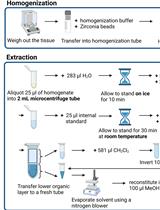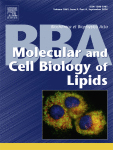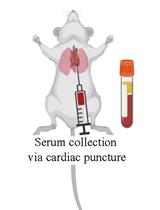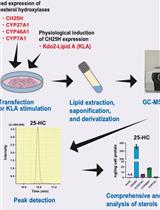- EN - English
- CN - 中文
Metabolic Heavy Isotope Labeling to Study Glycerophospholipid Homeostasis of Cultured Cells
代谢重同位素标记法研究培养细胞的甘油磷脂稳态
发布: 2017年05月05日第7卷第9期 DOI: 10.21769/BioProtoc.2268 浏览次数: 7367
评审: Neelanjan BoseMichael EnosAnonymous reviewer(s)

相关实验方案

使用多重反应监测(MRM)分析非酒精性脂肪性肝炎(NASH)小鼠肝匀浆中脂质分布的脂质组学工作流程
Hai Ning Wee [...] Jianhong Ching
2023年07月05日 2364 阅读
Abstract
Glycerophospholipids consist of a glycerophosphate backbone to which are esterified two acyl chains and a polar head group. The head group (e.g., choline, ethanolamine, serine or inositol) defines the glycerophospholipid class, while the acyl chains together with the head group define the glycerophospholipid molecular species. Stable heavy isotope (e.g., deuterium)-labeled head group precursors added to the culture medium incorporate efficiently into glycerophospholipids of mammalian cells, which allows one to determine the rates of synthesis, acyl chain remodeling or turnover of the individual glycerophospholipids using mass spectrometry. This protocol describes how to study the metabolism of the major mammalian glycerophospholipids i.e., phosphatidylcholines, phosphatidylethanolamines, phosphatidylserines and phosphatidylinositols with this approach.
Keywords: Glycerophospholipid (甘油磷脂)Background
Radiolabeled precursors have been extensively used to study glycerophospholipid (GPL) metabolism in cultured cells. However, this approach has serious drawbacks. First of all, it is unfeasible to study the metabolism of all molecular species of GPLs due to the fact that it is not possible, without reverting to highly complicated and time-consuming protocols, to separate the individual molecular species from each other (Patton et al., 1982), which is obviously necessary to study their metabolism. Second, the radioisotopes needed are quite expensive. Third, for optimal labeling, the unlabeled precursors should be depleted of the medium as much as possible. Fourth, only two different precursors (labeled with 3H or 14C) can be added to the cells simultaneously and even then accurate correction for the overlap between the isotope spectra is necessary upon liquid scintillation counting of the collected fractions. Because of those handicaps, a number of studies have recently introduced an alternative approach to study GPL metabolism (e.g., Heikinheimo and Somerharju, 2002; de Kroon, 2007; Kainu et al., 2008; Postle and Hunt, 2009; Kainu et al., 2013; Hermansson et al., 2016). This approach is based on the use of stable heavy isotope-labeled precursors and mass spectrometric (MS) analysis of GPL labeling. Clearly, this approach is far more convenient and efficient as compared to the traditional methods based on the use of radiolabeled precursors, due to the following facts: (a) multiple labeled precursors can be added simultaneously to the culture medium thus providing information on several GPL classes, (b) labeled and unlabeled GPLs can be conveniently and selectively detected using head group–specific scanning modes, (c) information is obtained on the turnover of individual GPL molecular species and (d) the stable heavy isotope-labeled precursors are generally much cheaper than the radiolabeled ones and can thus be added in amounts which avoids the use of special media depleted of the corresponding unlabeled precursors.
Materials and Reagents
- Pipette tips (Thermo Fisher Scientific, Thermo ScientificTM, catalog numbers: 9400327 , 9401255 , 9401410 )
- 35 or 60 mm cell culture dishes (Thermo Fisher Scientific, Thermo ScientificTM, catalog number: 153066 or 150288 )
- 12 ml screw-cap glass tubes (Kimble Chase Life Science and Research Products, catalog number: 45066A-16100 )
- Pasteur pipettes (BRAND, catalog number: 747720 )
- 12 x 32 mm screw-neck vials with caps (WATERS, catalog number: 186002640 )
- 11.5 x 75 mm test tubes (VWR, catalog number: ZZ130296772 )
- Cell scrapers and lifters (VWR, catalog numbers: 734-2603 and 734-2602 )
- HeLa cells or other cultured mammalian cells
- Phosphate buffered saline (PBS) (Merck Millipore, catalog number: 524650 )
- Methanol (VWR, catalog number: 83638.320 )
- Internal standards needed for mass spectrometric analyses:
- Di-20:1-phosphatidylcholine (PC) (Avanti Polar Lipids, catalog number: 850396 )
- Di-20:1-phosphatidylethanolamine (PE; synthesized in-house from corresponding PC) (Käkelä et al., 2003)
- Di-20:1-phosphatidylserine (PS; synthesized from corresponding PC) (Käkelä et al., 2003)
- Di-16:0-phosphatidylinositol (PI) (Avanti Polar Lipids, catalog number: 850141 )
- Chloroform (Merck Millipore, catalog number: 102445 )
- Acetonitrile, LC-MS grade (Fisher Scientific, catalog number: A/0638/17X )
- Isopropanol, OptimaTM LC/MS grade (Fisher Scientific, catalog number: A461-212 )
- Ammonium formate (Sigma-Aldrich, catalog number: 70221 )
- Ammonia solution 25% Suprapur (Merck Millipore, catalog number: 105428 )
- Acetic acid, glacial (Fisher Scientific, catalog number: 10171460 )
- Deuterium-labeled choline (D9-choline chloride) (C/D/N ISOTOPES, catalog number: D-2142 )
- Deuterium-labeled ethanolamine (D4-ethanolamine) (Cambridge Isotope Laboratories, catalog number: DLM-552-1 )
- Deuterium-labeled serine (D3-L-serine) (Cambridge Isotope Laboratories, catalog number: DLM-1073-1 )
- Deuterium-labeled inositol (D6-myo-inositol) (C/D/N ISOTOPES, catalog number: D-3019 )
- Hydroxylamine (Sigma-Aldrich, catalog number: 55460 )
- Dulbecco’s modified Eagle medium high glucose (DMEM) (Thermo Fisher Scientific, GibcoTM, catalog number: 41965039 ) or another medium appropriate for the cell line of interest
Note: We grew HeLa cells in DMEM containing 10% fetal calf serum and 100 U/ml penicillin and 100 U/ml streptomycin. - Choline chloride (Sigma-Aldrich, catalog number: C1879 )
- Ethanolamine (Merck Millipore, catalog number: 800849 )
- Myo-inositol (Sigma-Aldrich, catalog number: I5125 )
- L-serine (Sigma-Aldrich, catalog number: S4500 )
- Fetal bovine serum (FBS) (Sigma-Aldrich, catalog number: F7524 )
- Penicillin-streptomycin (Thermo Fisher Scientific, GibcoTM, catalog number: 15140122 )
- Milli-Q H2O (Elga Stat Maxima Reverse Osmosis Water Purifier)
- Nitrogen gas (Aga, Industrial gases, 99.95%)
- Labeling medium (see Recipes)
- Chase medium (see Recipes)
Equipment
- Pipettes (Thermo Fisher Scientific, Thermo ScientificTM, catalog numbers: 4600170 , 4600240 and 4600250 )
- Microliter syringe (Hamilton, model: 705 N, catalog number: 80565 )
- Vortex mixer (VWR, catalog number: 444-1372 )
- Centrifuge (Thermo Fisher Scientific, model: HeraeusTM MegafugeTM 1.0 )
- Fume hood
- Sample Concentrator with nitrogen evaporation (Cole-Parmer, Techne, catalog number: FSC400D )
- Mass spectrometer or analysis of the samples by a service provider
Note: We used Quattro Micro and Quattro Premier triple-quadrupole mass spectrometers (WATERS, model: Quattro Premier Mass Spectrometers ) - Acquity FTN Ultra Performance Liquid Chromatography instrument (WATERS, model: ACQUITY UPLC H-Class System )
- 1.0 x 150 mm Acquity BEH C18 column (WATERS, catalog number: 186002347 )
Software
- MassLynx 4.1 and QuanLynx software (WATERS)
- LIMSA software (Haimi et al., 2009)
Procedure
文章信息
版权信息
© 2017 The Authors; exclusive licensee Bio-protocol LLC.
如何引用
Hänninen, S., Somerharju, P. and Hermansson, M. (2017). Metabolic Heavy Isotope Labeling to Study Glycerophospholipid Homeostasis of Cultured Cells. Bio-protocol 7(9): e2268. DOI: 10.21769/BioProtoc.2268.
分类
生物化学 > 脂质 > 脂质测定
您对这篇实验方法有问题吗?
在此处发布您的问题,我们将邀请本文作者来回答。同时,我们会将您的问题发布到Bio-protocol Exchange,以便寻求社区成员的帮助。
Share
Bluesky
X
Copy link











